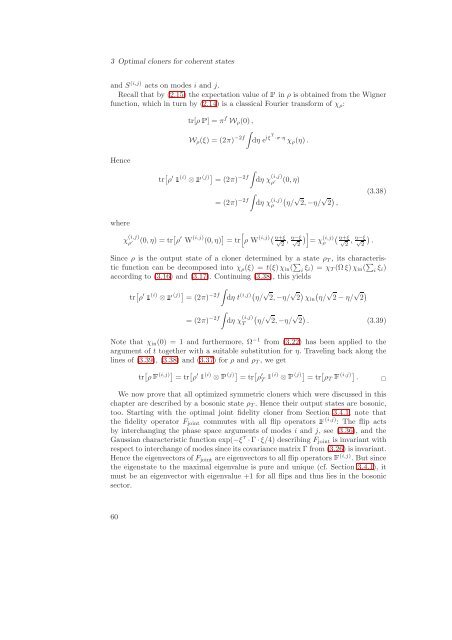Quantum Information Theory with Gaussian Systems
Quantum Information Theory with Gaussian Systems
Quantum Information Theory with Gaussian Systems
Create successful ePaper yourself
Turn your PDF publications into a flip-book with our unique Google optimized e-Paper software.
3 Optimal cloners for coherent states<br />
and S (i,j) acts on modes i and j.<br />
Recall that by (2.15) the expectation value ofÈin ρ is obtained from the Wigner<br />
function, which in turn by (2.14) is a classical Fourier transform of χρ:<br />
Hence<br />
tr[ρÈ] = π f Wρ(0),<br />
Wρ(ξ) = (2π) −2f<br />
<br />
tr ρ ′ (i) ⊗È(j) = (2π) −2f<br />
<br />
= (2π) −2f<br />
<br />
where<br />
χ (i,j)<br />
ρ ′ (0, η) = trρ ′ W (i,j) (0, η) <br />
= tr<br />
dη e iξT ·σ·η χρ(η).<br />
dη χ (i,j)<br />
ρ ′ (0, η)<br />
dη χ (i,j) √ √ <br />
ρ η/ 2, −η/ 2 ,<br />
ρ W (i,j) η+ξ<br />
√2 , η−ξ<br />
√<br />
2<br />
<br />
= χ (i,j)<br />
ρ<br />
η+ξ<br />
√2 , η−ξ<br />
√<br />
2<br />
(3.38)<br />
Since ρ is the output state of a cloner determined by a state ρT, its characteristic<br />
function can be decomposed into χρ(ξ) = t(ξ)χin( <br />
i ξi) = χT(Ω ξ)χin( <br />
i ξi)<br />
according to (3.16) and (3.17). Continuing (3.38), this yields<br />
tr ρ ′ (i) ⊗È(j) = (2π) −2f<br />
<br />
dη t (i,j) η/ √ 2, −η/ √ 2 √ √ <br />
χin η/ 2 − η/ 2<br />
= (2π) −2f<br />
<br />
dη χ (i,j) √ √ <br />
T η/ 2, −η/ 2 . (3.39)<br />
Note that χin(0) = 1 and furthermore, Ω −1 from (3.22) has been applied to the<br />
argument of t together <strong>with</strong> a suitable substitution for η. Traveling back along the<br />
lines of (3.39), (3.38) and (3.37) for ρ and ρT, we get<br />
tr ρ(i,j) = tr ρ ′ (i) ⊗È(j) = tr ρ ′ T (i) ⊗È(j) = tr ρT(i,j) . <br />
We now prove that all optimized symmetric cloners which were discussed in this<br />
chapter are described by a bosonic state ρT. Hence their output states are bosonic,<br />
too. Starting <strong>with</strong> the optimal joint fidelity cloner from Section 3.4.1, note that<br />
the fidelity operator Fjoint commutes <strong>with</strong> all flip operators(i,j) : The flip acts<br />
by interchanging the phase space arguments of modes i and j, see (3.36), and the<br />
<strong>Gaussian</strong> characteristic function exp(−ξ T · Γ · ξ/4) describing Fjoint is invariant <strong>with</strong><br />
respect to interchange of modes since its covariance matrix Γ from (3.26) is invariant.<br />
Hence the eigenvectors of Fjoint are eigenvectors to all flip operators(i,j) . But since<br />
the eigenstate to the maximal eigenvalue is pure and unique (cf. Section 3.4.1), it<br />
must be an eigenvector <strong>with</strong> eigenvalue +1 for all flips and thus lies in the bosonic<br />
sector.<br />
60<br />
.
















